The Tagus Estuary as a Numerical Modeling Test Bed: A Review
Abstract
1. Introduction
2. The Tagus Estuary
2.1. Overview
2.2. Hydrodynamics
2.3. Pollution
3. Brief Historical Background on Estuarine and Coastal Modeling
3.1. Estuarine and Coastal Hydrodynamics
3.2. Estuarine and Coastal Biogeochemistry
4. Modeling of the Tagus Estuary-costal Continuum
4.1. The 1980s
4.2. The 1990s
4.3. The 2000s
4.4. The 2010s
5. Future Challenges
- The increase of Sea level for the Portuguese coast is expected to occur within a range from 0.05 to 0.57 m [87,90,91]. If materialized, it will induce inundation of low-lying lands and erosion of sandy beaches, an increase in tidal prism with the potential to modify residence time and stratification, landward intrusion of salt water that increases salinization of agricultural fields and aquifers and displacement of ecosystems and habitat loss [91,92].
- Changes in the hydrologic regimes may occur as a result of predicted decrease in the precipitation regime of around 20% to 40% that will impact in the amount of freshwater discharged into the estuary, with a cascade effect on cohesive sediment availability [95] and, subsequently, on the light availability on the water column.
- The regulation by Spanish and Portuguese environmental authorities of dam discharges, which regulates, the main river tributaries, like the Tagus and Sorraia rivers, can affect the amount of freshwater discharging into the estuary leading to river forcing modulated by water pulses, which may act to change cohesive sediments, light availability and consequently estuarine primary production.
- Changes due to human interaction such as dredging operations that affect water columns depth, leading to changes in the Tagus estuary hydrodynamics.
- On the coast, the impact of changes in meteorological forcing, e.g., wind intensity and direction, will be a reality, affecting the propagation of estuarine plumes that transport particulate and solute materials onto the coastal sea. This may impact on the trophic levels, since local production could be affected.
Author Contributions
Funding
Acknowledgments
Conflicts of Interest
References
- Dame, R.F. Estuaries. In Encyclopedia of Ecology; Jorgensen, S.E., Fath, B., Eds.; Elsevier: Amsterdam, The Netherlands, 2008; pp. 1407–1413. ISBN 9780080454054. [Google Scholar]
- Jacobs, S.; Wolfstein, K.; Vandenbruwaene, W.; Vrebos, D.; Beauchard, O.; Maris, T.; Meire, P. Detecting ecosystem service trade-offs and synergies: A practice-oriented application in four industrialized estuaries. Ecosyst. Serv. 2015, 16, 378–389. [Google Scholar] [CrossRef]
- Boerema, A.; Meire, P. Management for estuarine ecosystem services: A review. Ecol. Eng. 2017, 98, 172–182. [Google Scholar] [CrossRef]
- Luisetti, T.; Turner, R.K.; Jickells, T.; Andrews, J.; Elliott, M.; Schaafsma, M.; Beaumont, N.; Malcolm, S.; Burdon, D.; Adams, C.; et al. Coastal Zone Ecosystem Services: From science to values and decision making; a case study. Sci. Total Environ. 2014, 493, 682–693. [Google Scholar] [CrossRef] [PubMed]
- Kirk Cochran, J. Estuaries. Ref. Modul. Earth Syst. Environ. Sci. 2014. [Google Scholar] [CrossRef]
- Potter, I.C.; Chuwen, B.M.; Hoeksema, S.D.; Elliott, M. The concept of an estuary: A definition that incorporates systems which can become closed to the ocean and hypersaline. Estuar. Coast. Shelf Sci. 2010, 87, 497–500. [Google Scholar] [CrossRef]
- Lotze, H.K.; Lenihan, H.S.; Bourque, B.J.; Bradbury, R.H.; Cooke, R.G.; Kay, M.C.; Kidwell, S.M.; Kirby, M.X.; Peterson, C.H.; Jackson, J.B.C. Depletion, Degradation, and Recovery Potential of Estuaries and Coastal Seas. Science 2006, 312, 1806–1809. [Google Scholar] [CrossRef]
- Hardisty, J. (Ed.) Estuaries: Monitoring and Modeling the Physical System; Wiley: Hoboken, NJ, USA, 2007. [Google Scholar]
- dit Durell, S.E.A.L.V.; Stillman, R.A.; Triplet, P.; Desprez, M.; Fagot, C.; Loquet, N.; Sueur, F.; Goss-Custard, J.D. Using an individual-based model to inform estuary management in the Baie de Somme, France. Oryx 2008, 42, 265–277. [Google Scholar] [CrossRef]
- Jovanovic, D.; Gelsinari, S.; Bruce, L.; Hipsey, M.; Teakle, I.; Barnes, M.; Coleman, R.; Deletic, A.; Mccarthy, D.T. Modelling shallow and narrow urban salt-wedge estuaries: Evaluation of model performance and sensitivity to optimise input data collection. Estuar. Coast. Shelf Sci. 2019, 217, 9–27. [Google Scholar] [CrossRef]
- Slinger, J.H. Hydro-morphological modelling of small, wave-dominated estuaries. Estuar. Coast. Shelf Sci. 2017, 198, 583–596. [Google Scholar] [CrossRef]
- Wolanski, E.; McLusky, D. (Eds.) Treatise on Estuarine and Coastal Science; Elsevier: Amsterdam, The Netherlands, 2011. [Google Scholar]
- Castanheiro, J.M. Distribution, transport and sedimentation of suspended matter in the Tejo Estuary. In Estuarine Processes: An Application to the Tagus Estuary; Secretaria de Estado Naturais, Ambiente e Recursos: Lisboa, Portugal, 1986; pp. 75–90. [Google Scholar]
- Portela, L.I.; Neves, R. Numerical modelling of suspended sediment transport in tidal estuaries: A comparison between the Tagus (Portugal) and the Scheldt (Belgium-the Netherlands). Netherlands J. Aquat. Ecol. 1994, 28, 329–335. [Google Scholar] [CrossRef]
- Pinto, P.J.; Kondolf, G.M. Evolution of Two Urbanized Estuaries: Environmental Change, Legal Framework, and Implications for Sea-Level Rise Vulnerability. Water 2016, 8, 535. [Google Scholar] [CrossRef]
- Vaz, N.; Fernandes, L.; Leitão, P.C.; Dias, J.M.; Neves, R.; Manuel, A. The Tagus Estuarine Plume Induced By Wind and River Runoff: Winter 2007 Case Study. J. Coast. Res. 2009, SI 56, 1090–1094. [Google Scholar]
- Neves, F.J. Dynamics and Hydrology of the Tagus Estuary: Results from In Situ Observations; University of Lisbon: Lisbon, Portugal, 2010. [Google Scholar]
- Rodrigues, M.; Fortunato, A.B. Assessment of a three-dimensional baroclinic circulation model of the Tagus estuary (Portugal). AIMS Environ. Sci. 2017, 4, 763–787. [Google Scholar] [CrossRef]
- Vaz, N.; Dias, J.M. Residual currents and transport pathways in the Tagus estuary, Portugal: the role of freshwater discharge and wind. J. Coast. Res. 2014, 70, 610–615. [Google Scholar] [CrossRef]
- Fortunato, A.; Baptista, A.; Luettich, R. A three-dimensional model of tidal currents in the mouth of the Tagus estuary. Cont. Shelf Res. 1997, 17, 1689–1714. [Google Scholar] [CrossRef]
- Jouanneau, J.M.; Garcia, C.; Oliveira, A.; Rodrigues, A.; Dias, J.A.; Weber, O. Dispersal and deposition of suspended sediment on the shelf off the Tagus and Sado estuaries, S.W. Portugal. Prog. Oceanogr. 1998, 42, 233–257. [Google Scholar] [CrossRef]
- Vaz, N.; Mateus, M.; Plecha, S.; Sousa, M.C.; Leitão, P.C.; Neves, R.; Dias, J.M. Modeling SST and chlorophyll patterns in a coupled estuary-coastal system of Portugal: The Tagus case study. J. Mar. Syst. 2015, 147, 123–137. [Google Scholar] [CrossRef]
- Carvalho, F.P.; Oliveira, J.M.; Silva, L.; Malta, M. Radioactivity of anthropogenic origin in the Tejo Estuary and need for improved waste management and environmental monitoring. Int. J. Environ. Stud. 2013, 70, 952–963. [Google Scholar] [CrossRef]
- Caetano, M.; Madureira, M.-J.; Vale, C. Metal Remobilisation during Resuspension of Anoxic Contaminated Sediment: Short-Term Laboratory Study. Water. Air. Soil Pollut. 2003, 143, 23–40. [Google Scholar] [CrossRef]
- Hansen, D.V. Gravitational circulation in straits and estuaries. J. Mar. Res. 1965, 23, 104–122. [Google Scholar]
- Geyer, W.R.; MacCready, P. The Estuarine Circulation. Annu. Rev. Fluid Mech. 2014, 46, 175–197. [Google Scholar] [CrossRef]
- Festa, J.F.; Hansen, D. V A two-dimensional numerical model of estuarine circulation: The effects of altering depth and river discharge. Estuar. Coast. Mar. Sci. 1976, 4, 309–323. [Google Scholar] [CrossRef]
- Cheng, R.T.; Casulli, V.; Gartner, J.W. Tidal, Residual, Intertidal Mudflat (TRIM) Model and its Applications to San Francisco Bay, California. Estuar. Coast. Shelf Sci. 1993, 36, 235–280. [Google Scholar] [CrossRef]
- Vaz, N.; Dias, J.M.; Leitão, P.; Martins, I. Horizontal patterns of water temperature and salinity in an estuarine tidal channel: Ria de Aveiro. Ocean Dyn. 2005, 55, 416–429. [Google Scholar] [CrossRef]
- Umlauf, L.; Burchard, H. A generic length-scale equation for geophysical turbulence models. J. Mar. Res. 2003, 61, 235–265. [Google Scholar] [CrossRef]
- Zhao, L.; Chen, C.; Vallino, J.; Hopkinson, C.; Beardsley, R.C.; Lin, H.; Lerczak, J. Wetland-estuarine-shelf interactions in the Plum Island Sound and Merrimack River in the Massachusetts coast. J. Geophys. Res. Ocean. 2010, 115, C10. [Google Scholar] [CrossRef]
- Riley, G.A.; Stommel, H.; Bumpus, D.F. Quantitative Ecology of the Plankton of the Western North Atlantic. Bull. Bingham Oceanogr. 1949, 12, 1–169, Collection. [Google Scholar]
- Brush, M.J.; Harris, L.A. Introduction to the special issue of Ecological Modelling: “Advances in Modeling Estuarine and Coastal Ecosystems: Approaches, Validation, and Applications”. Ecol. Modell. 2010, 221, 965–968. [Google Scholar] [CrossRef]
- DiToro, M.D. A dynamic model of the phytoplankton population in the Sacramento-San Joaquin delta. Advan.in Chem Ser. 1971, 106, 262–267. [Google Scholar]
- Steele, J.H. The Structure of Marine Ecosystems; Harvard University Press: Cambridge, MA, USA, 1974. [Google Scholar]
- Kremer, J.N.; Nixon, S.W. A Coastal Marine Ecosystem: Simulation and Analysis; Springer: New York, NY, USA, 1978. [Google Scholar]
- HydroQual A Steady-State Coupled Hydrodynamic/Water Quality Model of the Eutrophication and Anoxia Process in Chesapeake Bay; HydroQual Inc.: Mahwah, NJ, USA, 1987.
- Baretta, J.; Ruardij, P. Tidal Flat Estuaries: Simulation and Analysis of the Ems Estuary; Springer: Berlin, Germany, 1988. [Google Scholar]
- Billen, G.; Garnier, J. The Phison River plume: coastal eutrophication in response to changes in land use and water management in the watershed. Aquat. Microb. Ecol. 1997, 13, 3–17. [Google Scholar] [CrossRef]
- Baretta-Bekker, J.G.; Baretta, J.W.; Ebenhöh, W. Microbial dynamics in the marine ecosystem model ERSEM II with decoupled carbon assimilation and nutrient uptake. J. Sea Res. 1997, 38, 195–211. [Google Scholar] [CrossRef]
- Baretta, J.W.; Ebenhöh, W.; Ruardij, P. The European regional seas ecosystem model, a complex marine ecosystem model. Netherlands J. Sea Res. 1995, 33, 233–246. [Google Scholar] [CrossRef]
- Friedrichs, M.A.M.; Hood, R.R.; Wiggert, J.D. Ecosystem model complexity versus physical forcing: Quantification of their relative impact with assimilated Arabian Sea data. Deep Sea Res. Part II Top. Stud. Oceanogr. 2006, 53, 576–600. [Google Scholar] [CrossRef]
- Duarte, C.M.; Amthor, J.S.; DeAngelis, D.L.; Joyce, L.A.; Maranger, R.J.; Pace, M.L.; Pastor, J.; Running, S.W. The limits to models in ecology. In Models in Ecosystem Science; Canham, C.D., Cole, J.J., Lauenroth, W.K., Eds.; Princeton University Press: Princeton, NJ, USA, 2003; pp. 437–451. [Google Scholar]
- Arndt, S.; Lacroix, G.; Gypens, N.; Regnier, P.; Lancelot, C. Nutrient dynamics and phytoplankton development along an estuary–coastal zone continuum: A model study. J. Mar. Syst. 2011, 84, 49–66. [Google Scholar] [CrossRef]
- Lopes, J.F.; Vaz, N.; Vaz, L.; Ferreira, J.A.; Dias, J.M. Assessing the state of the lower level of the trophic web of a temperate lagoon, in situations of light or nutrient stress: A modeling study. Ecol. Modell. 2015, 313, 59–76. [Google Scholar] [CrossRef]
- Dijkstra, Y.M.; Chant, R.J.; Reinfelder, J.R. Factors Controlling Seasonal Phytoplankton Dynamics in the Delaware River Estuary: An Idealized Model Study. Estuaries Coasts 2019, 42, 1839–1857. [Google Scholar] [CrossRef]
- Trancoso, A.R.; Saraiva, S.; Fernandes, L.; Pina, P.; Leitão, P.; Neves, R. Modelling macroalgae using a 3D hydrodynamic-ecological model in a shallow, temperate estuary. Ecol. Modell. 2005, 187, 232–246. [Google Scholar] [CrossRef]
- Mateus, M.; Vaz, N.; Neves, R. A process-oriented model of pelagic biogeochemistry for marine systems. Part II: Application to a mesotidal estuary. J. Mar. Syst. 2012, 94, S90–S101. [Google Scholar] [CrossRef]
- Fringer, O.B.; Dawson, C.N.; He, R.; Ralston, D.K.; Zhang, Y.J. The future of coastal and estuarine modeling: Findings from a workshop. Ocean Model. 2019, 143, 101458. [Google Scholar] [CrossRef]
- Câmara, A.S.; Néo, F.A.; Ribeiro, M.T.G.; Painho, M.T. Estuarine Water Quality Management—A New Approach. IFAC Proc. Vol. 1985, 18, 63–67. [Google Scholar] [CrossRef]
- Barros, A.P. An evaluation of model parameterizations of sediment pathways: A case study for the Tejo estuary. Cont. Shelf Res. 1996, 16, 1725–1749. [Google Scholar] [CrossRef]
- Ferreira, J.G. ECOWIN—An object-oriented ecological model for aquatic ecosystems. Ecol. Modell. 1995, 79, 21–34. [Google Scholar] [CrossRef]
- Heip, C.; Herman, P.M.J. Major biological processes in European tidal estuaries: A synthesis of the JEEP-92 Project. Hydro 1995, 311, 1–7. [Google Scholar] [CrossRef]
- Carvalho, F.P. Distribution, cycling and mean residence time of 226Ra, 210Pb and 210Po in the Tagus estuary. Sci. Total Environ. 1997, 196, 151–161. [Google Scholar] [CrossRef]
- Fortunato, A.; Oliveira, A. On the effect of tidal flats on the hydrodynamics of the Tagus estuary. Oceanol. Acta 1999, 22, 31–44. [Google Scholar] [CrossRef]
- Simas, T.; Nunes, J.P.; Ferreira, J.G. Effects of global climate change on coastal salt marshes. Ecol. Modell. 2001, 139, 1–15. [Google Scholar] [CrossRef]
- Simas, T.C.; Ferreira, J.G. Nutrient enrichment and the role of salt marshes in the Tagus estuary (Portugal). Estuar. Coast. Shelf Sci. 2007, 75, 393–407. [Google Scholar] [CrossRef]
- Silva, H.; Dias, J.M.; Caçador, I. Is the salt marsh vegetation a determining factor in the sedimentation processes? Hydrobiologia 2009, 621, 33–47. [Google Scholar] [CrossRef]
- Carmo, J.S.A. Near-shore sediment dynamics computation under the combined effects of waves and currents. Adv. Eng. Softw. 2002, 33, 37–48. [Google Scholar] [CrossRef]
- Braunschweig, F.; Martins, F.; Chambel, P.; Neves, R. A methodology to estimate renewal time scales in estuaries: the Tagus Estuary case. Ocean Dyn. 2003, 53, 137–145. [Google Scholar] [CrossRef]
- Braunschweig, F.; Leitao, P.C.; Fernandes, L.; Pina, P.; Neves, R.J.J. The object-oriented design of the integrated water modelling system MOHID. Dev. Water Sci. 2004, 55, 1079–1090. [Google Scholar]
- Alvera-Azcárate, A.; Ferreira, J.G.; Nunes, J.P. Modelling eutrophication in mesotidal and macrotidal estuaries. The role of intertidal seaweeds. Estuar. Coast. Shelf Sci. 2003, 57, 715–724. [Google Scholar] [CrossRef]
- Saraiva, S.; Pina, P.; Martins, F.; Santos, M.; Braunschweig, F.; Neves, R. Modelling the influence of nutrient loads on Portuguese estuaries. Hydrobiologia 2007, 587, 5–18. [Google Scholar] [CrossRef]
- Mateus, M.; Neves, R. Evaluating light and nutrient limitation in the Tagus estuary using a process-oriented ecological model. J. Mar. Eng. Technol. 2008, 7, 43–54. [Google Scholar] [CrossRef]
- Rusu, L.; Bernardino, M.; Guedes Soares, C. Modelling the influence of currents on wave propagation at the entrance of the Tagus estuary. Ocean Eng. 2011, 38, 1174–1183. [Google Scholar] [CrossRef]
- Vaz, N.; Mateus, M.; Dias, J.M. Semidiurnal and spring-neap variations in the Tagus Estuary: Application of a process-oriented hydro-biogeochemical model. J. Coast. Res. 2011, SI 64, 1619–1623. [Google Scholar]
- Dias, J.M.; Valentim, J.M. Numerical modeling of Tagus estuary tidal dynamics. J. Coast. Res. SI 64 2011, 1495–1499. [Google Scholar]
- Dias, J.M.; Valentim, J.M.; Sousa, M.C. A numerical study of local variations in tidal regime of Tagus estuary, Portugal. PLoS ONE 2013, 8, e80450. [Google Scholar] [CrossRef]
- Valentim, J.M.; Vaz, N.; Silva, H.; Duarte, B.; Caçador, I.; Dias, J.M. Tagus estuary and Ria de Aveiro salt marsh dynamics and the impact of sea level rise. Estuar. Coast. Shelf Sci. 2013, 130, 138–151. [Google Scholar] [CrossRef]
- Valentim, J.M.; Vaz, L.; Vaz, N.; Silva, H.; Duarte, B.; Caçador, I.; Dias, J.M. Sea level rise impact in residual circulation in Tagus estuary and Ria de Aveiro lagoon. J. Coast. Res. 2013, 65, 1981–1986. [Google Scholar] [CrossRef]
- Guerreiro, M.; Fortunato, A.B.; Freire, P.; Rilo, A.; Taborda, R. Evolution of the hydrodynamics of the Tagus estuary (Portugal) in the 21 st century. J. Integr. Coast. Zo. Manag. 2015, 15, 65–80. [Google Scholar]
- Fortunato, A.B.; Freire, P.; Bertin, X.; Rodrigues, M.; Ferreira, J.; Liberato, M.L.R. A numerical study of the February 15, 1941 storm in the Tagus estuary. Cont. Shelf Res. 2017, 144, 50–64. [Google Scholar] [CrossRef]
- Mateus, M.; Oliveira, A.P. A numerical study of CO2 dynamics in the Tagus estuary. In Ocean Modelling for Coastal Management—Case Studies with MOHID; Mateus, M., Neves, R., Eds.; IST Press: Lisbon, Portugal, 2013; pp. 185–197. [Google Scholar]
- Pinto, L.; Mateus, M.; Ascione, I.; Franz, G.; Neves, R. Modelling mussel growth in Tagus estuary: A preliminary approach. In Ocean Modelling for Coastal Management—Case Studies with MOHID; Mateus, M., Neves, R., Eds.; IST Press: Lisbon, Portugal, 2013; pp. 175–183. [Google Scholar]
- de Pablo, H.; Brito, D.; Mateus, M.; Trancoso, A.R.; Campuzano, F.J.N.; Pinto, L.; Neves, R. An integration methodology to estimate water fluxes and constituents budgets in coastal area. In Ocean Modelling for Coastal Management: Case Studies with MOHID; Mateus, M., Neves, R., Eds.; IST Press: Lisbon, Portugal, 2013; ISBN 978-989-8481-24-5. [Google Scholar]
- Póvoa, P.; Nobre, A.; Leitão, P.; Galvão, P.; Santos, H.; Frazão, A.; Neves, R.; Matos, J.S. Operational decision support system for large combined sewage systems: Lisbon/Tagus estuary case study. Water Sci. Technol. 2015, 72, 1421–1427. [Google Scholar] [CrossRef] [PubMed][Green Version]
- Oliveira, A.P.; Mateus, M.D.; Cabeçadas, G.; Neves, R. Water-air CO2 fluxes in the Tagus estuary plume (Portugal) during two distinct winter episodes. Carbon Balance Manag. 2015, 10, 2. [Google Scholar] [CrossRef]
- Franz, G.; Pinto, L.; Ascione, I.; Mateus, M.; Fernandes, R.; Leitão, P.; Neves, R. Modelling of cohesive sediment dynamics in tidal estuarine systems: Case study of Tagus estuary, Portugal. Estuar. Coast. Shelf Sci. 2014, 151, 34–44. [Google Scholar] [CrossRef]
- Franz, G.; Leitão, P.; Pinto, L.; Jauch, E.; Fernandes, L.; Neves, R. Development and validation of a morphological model for multiple sediment classes. Int. J. Sediment Res. 2017, 32, 585–596. [Google Scholar] [CrossRef]
- França, S.; Vasconcelos, R.P.; Fonseca, V.F.; Tanner, S.E.; Reis-Santos, P.; Costa, M.J.; Cabral, H.N. Predicting fish community properties within estuaries: Influence of habitat type and other environmental features. Estuar. Coast. Shelf Sci. 2012, 107, 22–31. [Google Scholar] [CrossRef]
- Fonseca, V.F.; Neill, W.H.; Miller, J.M.; Cabral, H.N. Ecophys.Fish perspectives on growth of juvenile soles, Solea solea and Solea senegalensis, in the Tagus estuary, Portugal. J. Sea Res. 2010, 64, 118–124. [Google Scholar] [CrossRef]
- Vasconcelos, R.P.; Reis-Santos, P.; Maia, A.; Fonseca, V.; França, S.; Wouters, N.; Costa, M.J.; Cabral, H.N. Nursery use patterns of commercially important marine fish species in estuarine systems along the Portuguese coast. Estuar. Coast. Shelf Sci. 2010, 86, 613–624. [Google Scholar] [CrossRef]
- França, S.; Cabral, H.N. Predicting fish species richness in estuaries: Which modelling technique to use? Environ. Model. Softw. 2015, 66, 17–26. [Google Scholar] [CrossRef]
- França, S.; Cabral, H.N. Predicting fish species distribution in estuaries: Influence of species’ ecology in model accuracy. Estuar. Coast. Shelf Sci. 2016, 180, 11–20. [Google Scholar] [CrossRef]
- Duarte, B.; Vaz, N.; Valentim, J.M.; Dias, J.M.; Silva, H.; Marques, J.C.; Sleimi, N.; Caçador, I. Revisiting the outwelling hypothesis: Modelling salt marsh detrital metal exports under extreme climatic events. Mar. Chem. 2017, 191, 24–33. [Google Scholar] [CrossRef]
- Vaz, N.; Rodrigues, J.G.; Mateus, M.; Franz, G.; Campuzano, F.; Neves, R.; Dias, J.M. Subtidal variability of the Tagus river plume in winter 2013. Sci. Total Environ. 2018, 627, 1353–1362. [Google Scholar] [CrossRef] [PubMed]
- Antunes, C.; Taborda, R. Sea level at Cascais tide gauge: data, analysis and results. J. Coast. Res. 2009, 56 (SI), 218–222. [Google Scholar]
- de Pablo, H.; Sobrinho, J.; Garcia, M.; Campuzano, F.; Juliano, M.; Neves, R. Validation of the 3D-MOHID Hydrodynamic Model for the Tagus Coastal Area. Water 2019, 11, 1713. [Google Scholar] [CrossRef]
- Rodrigues, M.; Fortunato, A.B.; Freire, P. Saltwater intrusion in the upper Tagus Estuary during droughts. Geosciences 2019, 9, 400. [Google Scholar] [CrossRef]
- Dias, J.A.; Taborda, R. Evolução recente do nível médio do mar em Portugal. An. do Inst. Hidrográfico 1988, 9, 83–97. [Google Scholar]
- Lopes, C.L.; Silva, P.A.; Dias, J.M.; Rocha, A.; Picado, A.; Plecha, S.; Fortunato, A.B. Local sea level change scenarios for the end of the 21st century and potential physical impacts in the lower Ria de Aveiro (Portugal). Cont. Shelf Res. 2011, 31, 1515–1526. [Google Scholar] [CrossRef]
- Pethick, J. Coastal management and sea-level rise. CATENA 2001, 42, 307–322. [Google Scholar] [CrossRef]
- Statham, P.J. Nutrients in estuaries—An overview and the potential impacts of climate change. Sci. Total Environ. 2012, 434, 213–227. [Google Scholar] [CrossRef]
- Pereira, S.C.; Marta-Almeida, M.; Carvalho, A.C.; Rocha, A. Heat wave and cold spell changes in Iberia for a future climate scenario. Int. J. Climatol. 2017, 37, 5192–5205. [Google Scholar] [CrossRef]
- Vaz, N.; Vaz, L.; Serôdio, J.; Dias, J.M. A modeling study of light extinction due to cohesive sediments in a shallow coastal lagoon under well mixed conditions. Sci. Total Environ. 2019, 694, 133707. [Google Scholar] [CrossRef] [PubMed]
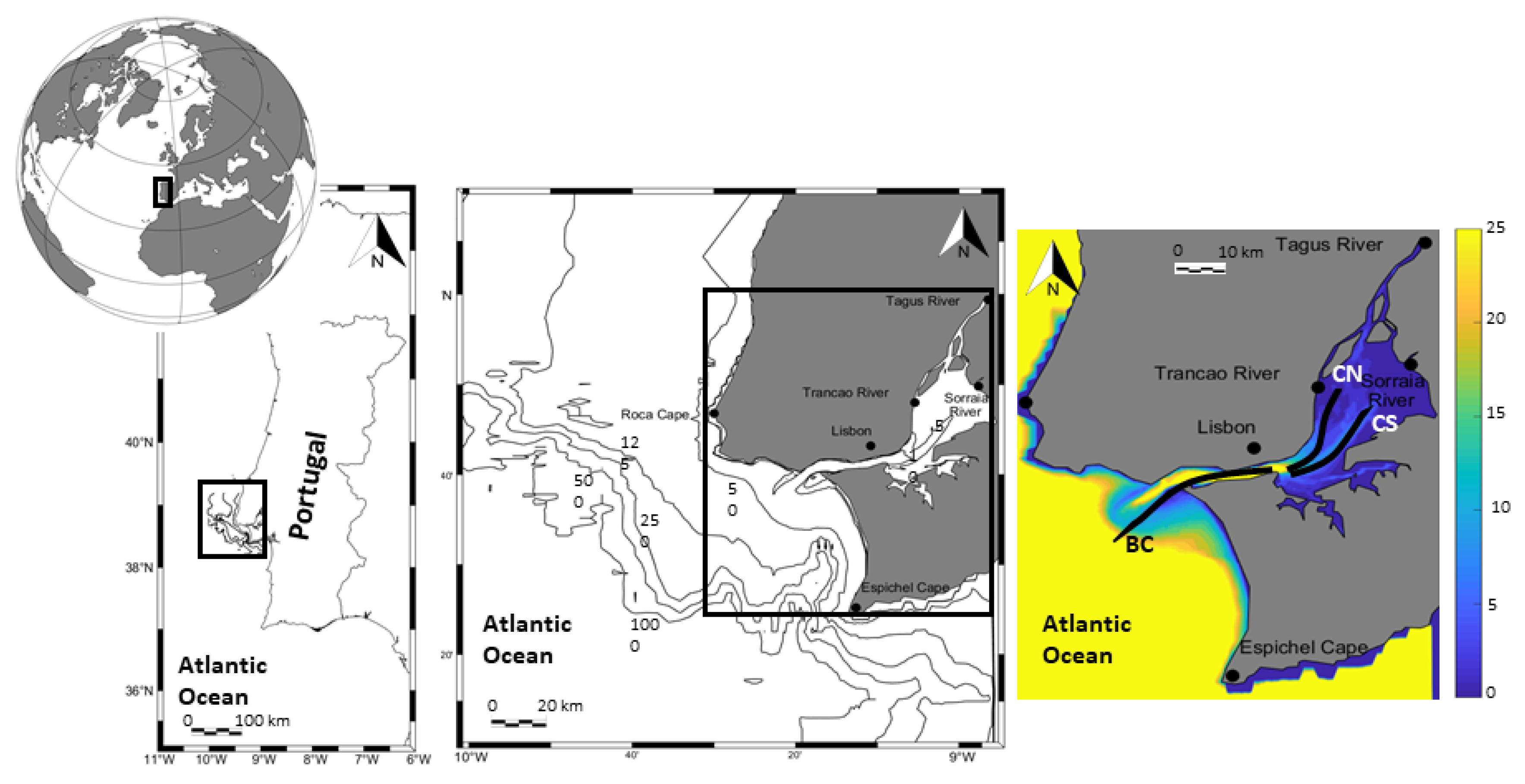
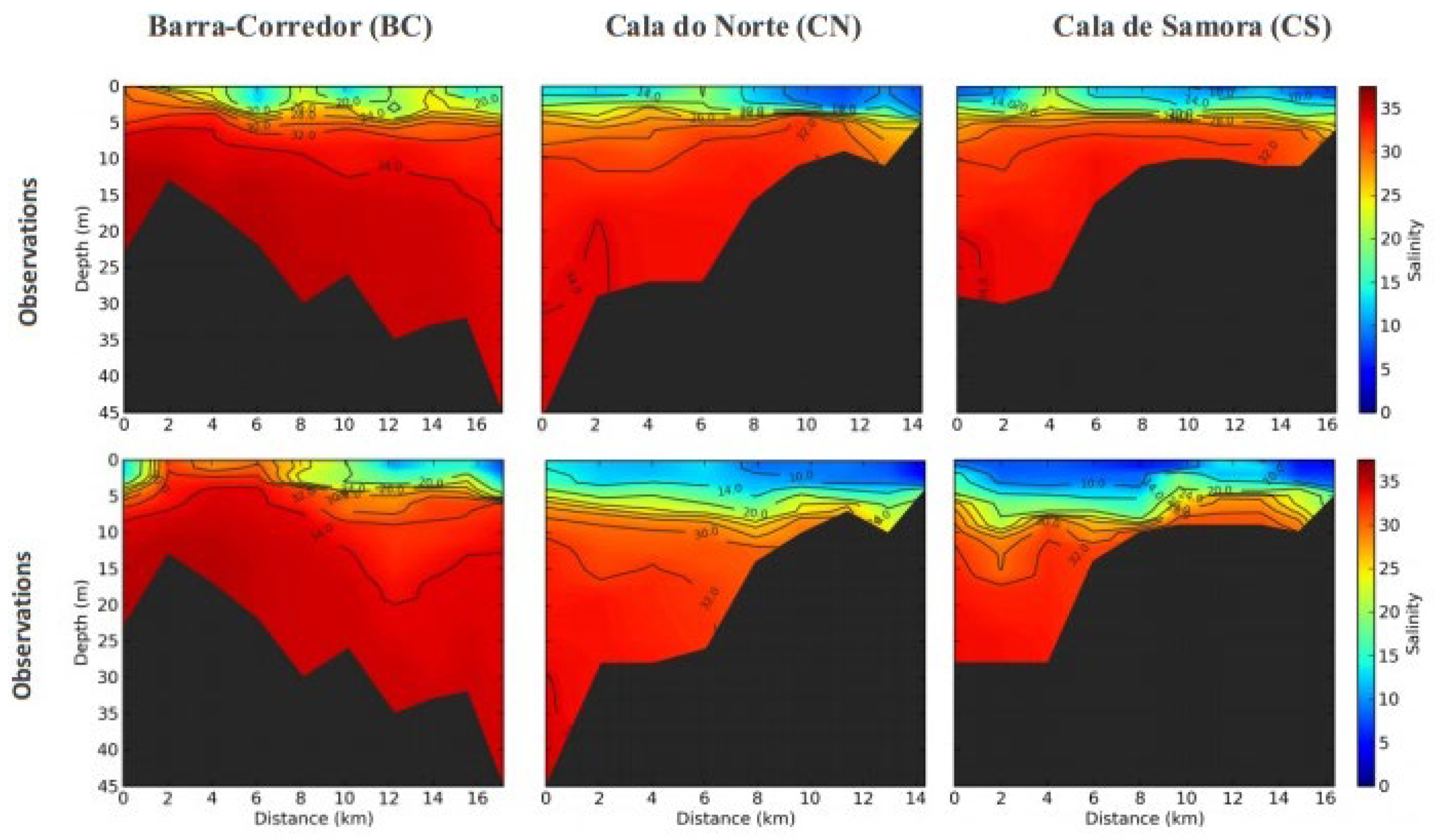

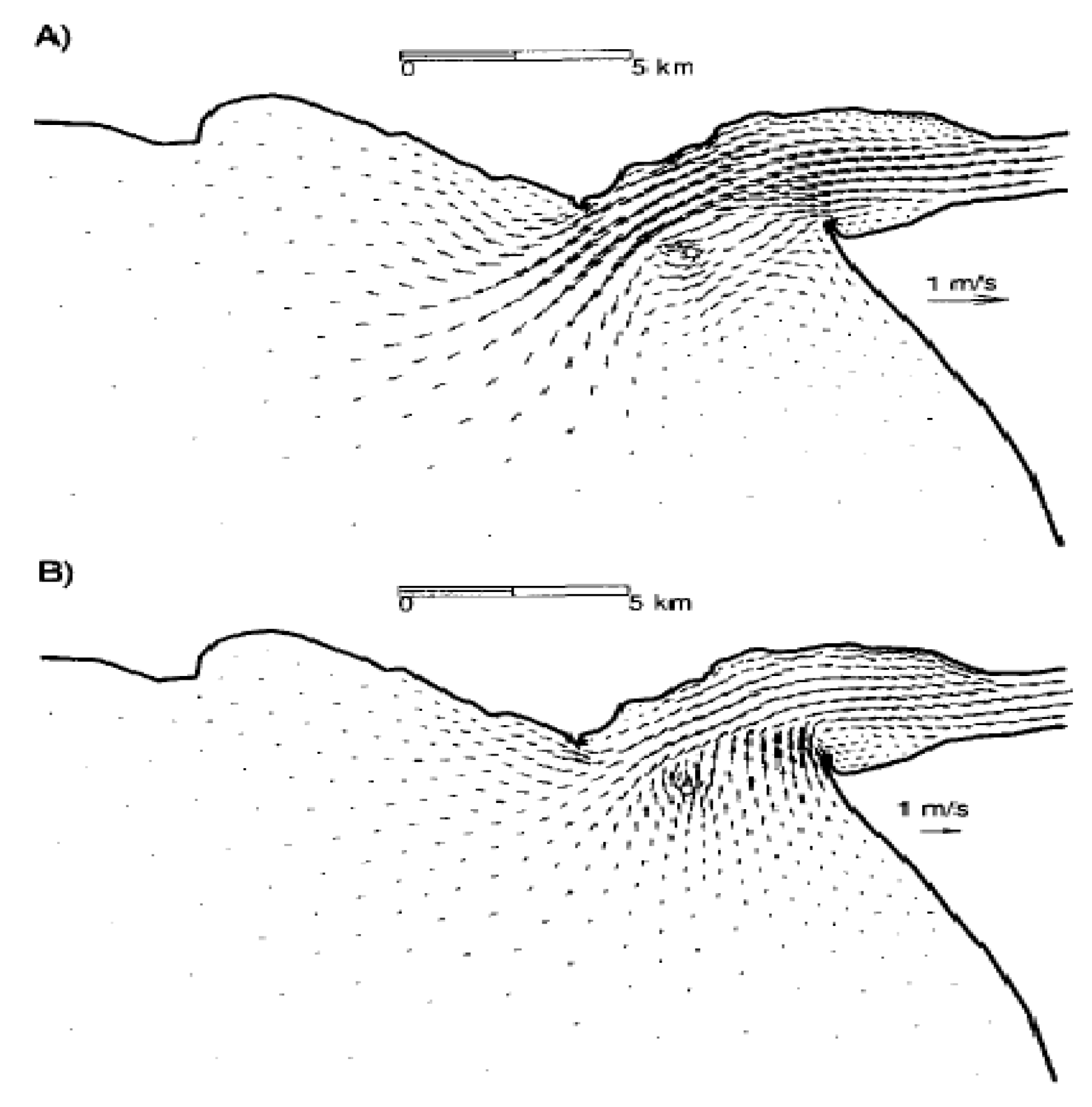

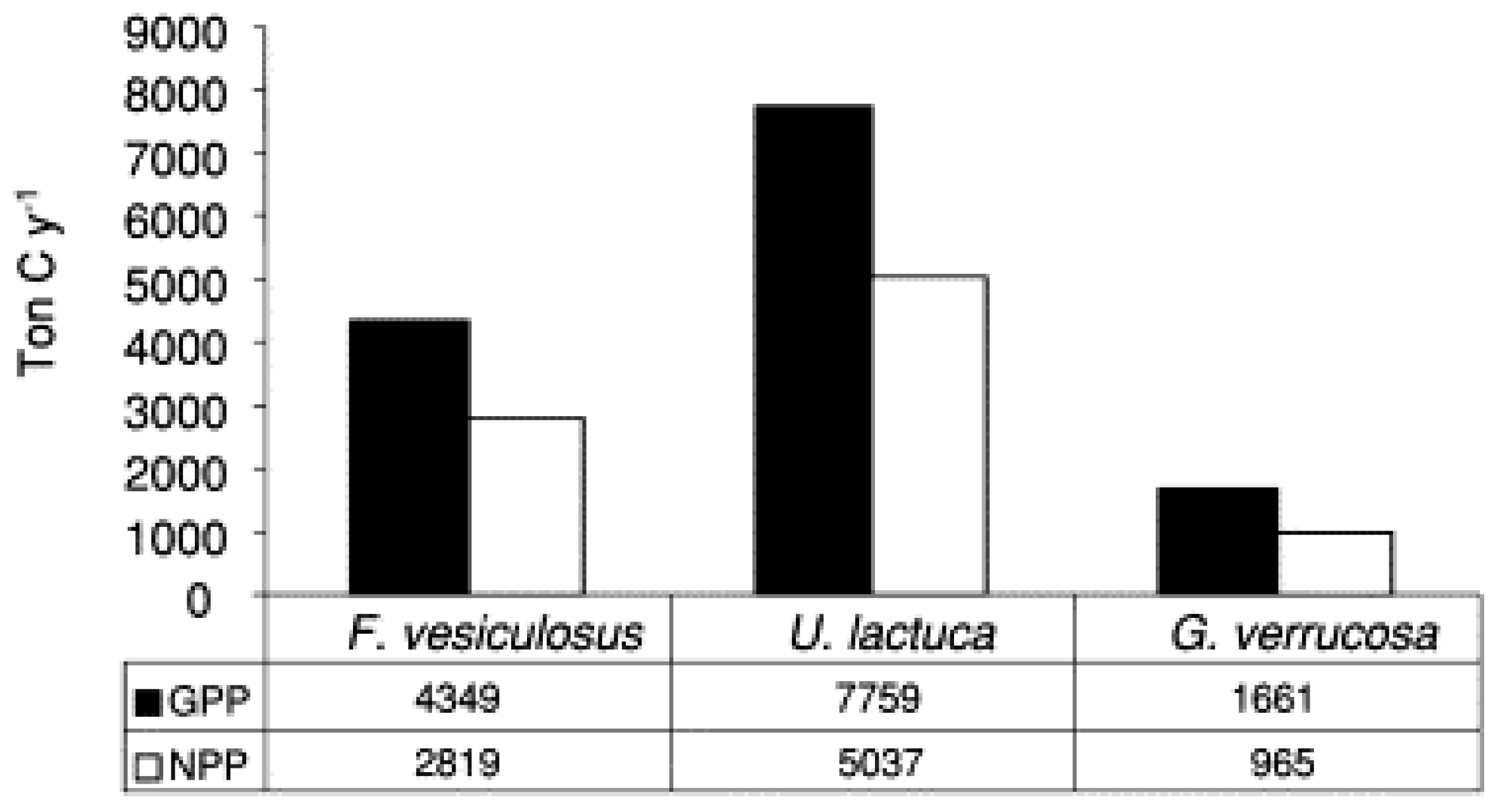
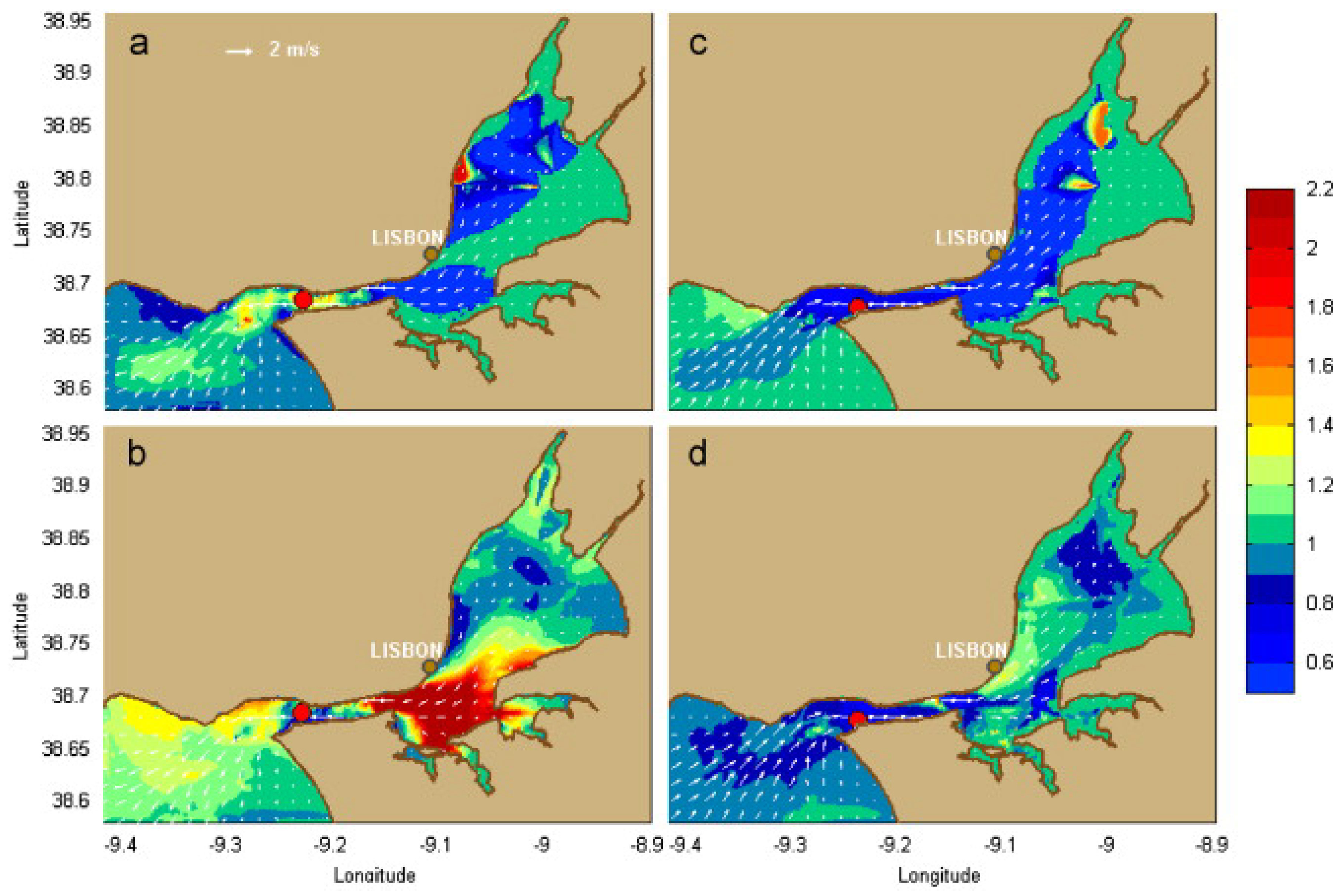

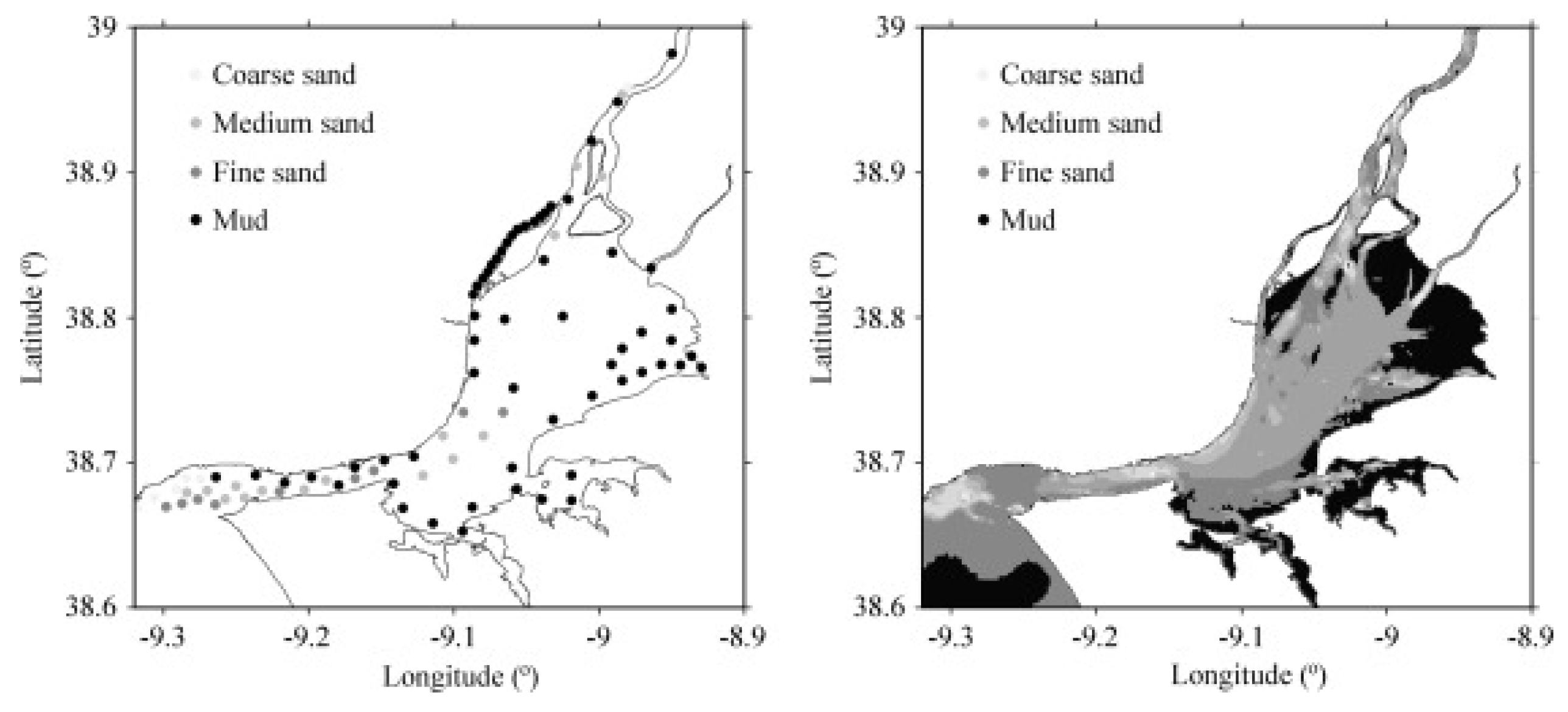
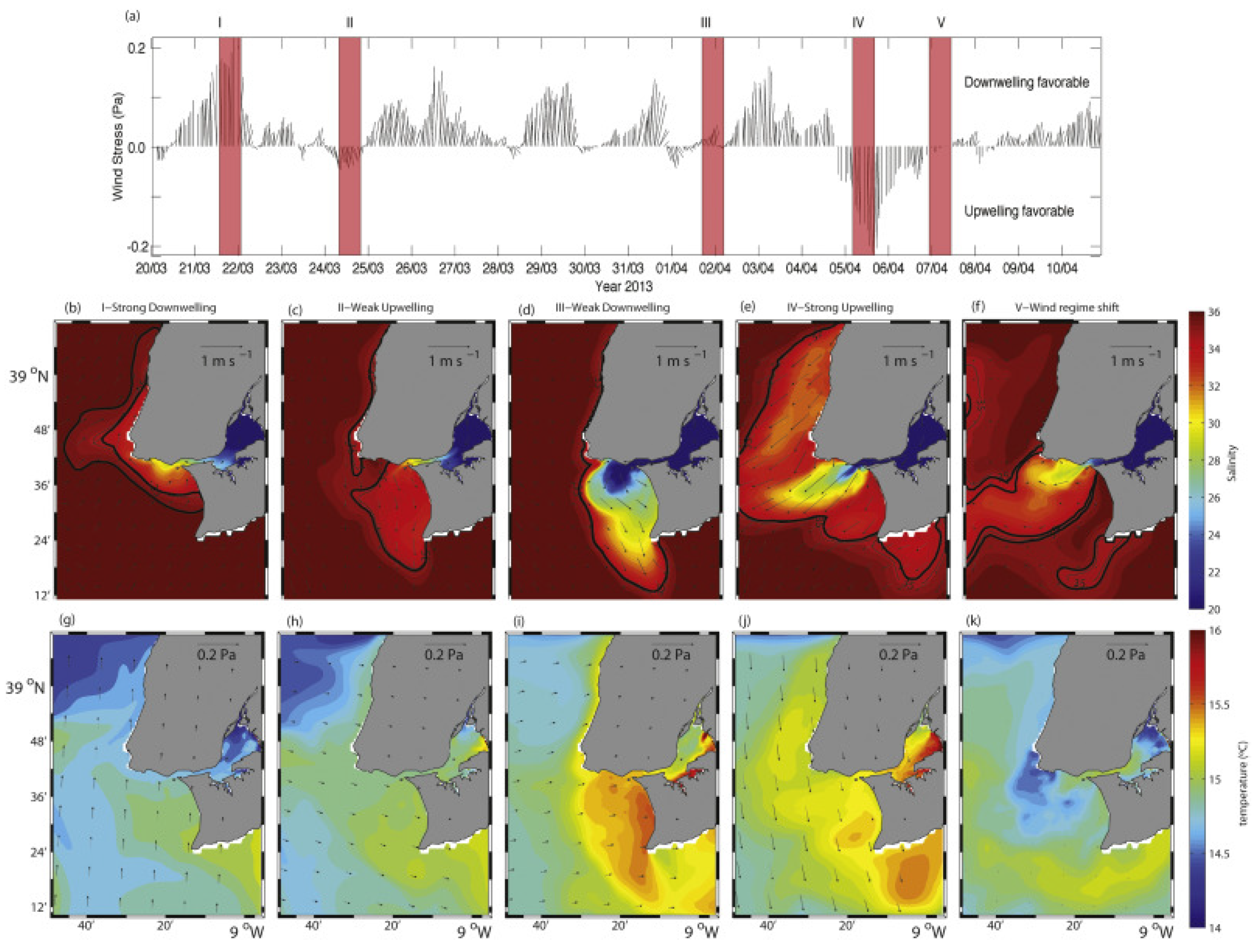
| Lisbon Metropolitan Area | |
| Population | 2,821, 876 |
| Total area | 3002 km2 |
| Population Density | 940 per km2 |
| Tagus Estuary | |
| Water surface at high tide area | 320 km2 |
| Mudflats area | 152 km2 |
| Low marsh area | 4.4 km2 |
| Salt ponds area | <1 km2 |
| Mean tidal range | 2.4 m |
| Mean tidal prism | 7.5 × 108 m3 |
| Tagus Basin | |
| Catchment area | 80,629 km2 |
| Annual average unimpaired flow into estuary | 17,004 hm3 |
| Average annual flow into estuary | ~12,500 hm3 |
| Average annual sediment influx into estuary | 1–5 × 106 metric ton/year |
| Model | Citation | C/R | (FV)/(FE) | Vertical Coordinate |
|---|---|---|---|---|
| ADCIRC | https://adcirc.org/ | C | FE | Sigma |
| COAWST | https://www.usgs.gov/software/coupled-ocean-atmosphere-wave-sediment-transport-coawst-modeling-system | C/R | FV | Sigma |
| Delft3D | Oss.deltares.nl/web/delft3d/home | C | FV | Sigma |
| ECOM/POM | http://www.ccpo.odu.edu/POMWEB/ | C/R | FV | Sigma |
| FVCOM | http://fvcom.smast.umassd.edu/ | C/R | FV | Sigma |
| GETM | https://getm.eu/ | C | FV | Sigma/adaptive |
| MARS3D | https://wwz.ifremer.fr/mars3d | C/R | FV | Sigma |
| MITgcm | http://mitgcm.org/ | C/R | FV | Z |
| MOHID | http://www.mohid.com/ | C/R | FV | Sigma/adaptive |
| ROMS | https://www.myroms.org/ | R | FV | Sigma |
| SCHISM | http://ccrm.vims.edu/schismweb/ | C/R | FV/FE | Z/Sigma |
| SELFE | http://www.stccmop.org/knowledge_transfer/software/selfe | C | FV/FE | Z/Sigma |
| SHYFEM | https://www.cmcc.it/models/shyfem-shallow-water-hydrodynamic-finite-element-model | C | FE | Z/Sigma |
| SUNTANS | https://github.com/ofringer/suntans | C | FV | Z |
© 2019 by the authors. Licensee MDPI, Basel, Switzerland. This article is an open access article distributed under the terms and conditions of the Creative Commons Attribution (CC BY) license (http://creativecommons.org/licenses/by/4.0/).
Share and Cite
Vaz, N.; Mateus, M.; Pinto, L.; Neves, R.; Dias, J.M. The Tagus Estuary as a Numerical Modeling Test Bed: A Review. Geosciences 2020, 10, 4. https://doi.org/10.3390/geosciences10010004
Vaz N, Mateus M, Pinto L, Neves R, Dias JM. The Tagus Estuary as a Numerical Modeling Test Bed: A Review. Geosciences. 2020; 10(1):4. https://doi.org/10.3390/geosciences10010004
Chicago/Turabian StyleVaz, Nuno, Marcos Mateus, Lígia Pinto, Ramiro Neves, and João Miguel Dias. 2020. "The Tagus Estuary as a Numerical Modeling Test Bed: A Review" Geosciences 10, no. 1: 4. https://doi.org/10.3390/geosciences10010004
APA StyleVaz, N., Mateus, M., Pinto, L., Neves, R., & Dias, J. M. (2020). The Tagus Estuary as a Numerical Modeling Test Bed: A Review. Geosciences, 10(1), 4. https://doi.org/10.3390/geosciences10010004









